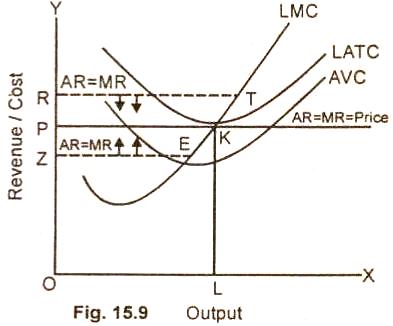Long Run Equilibrium of the Price Taker Firm:
Definition:
"All the
firms in a competitive industry achieve long run equilibrium when market price
or marginal revenue equals
marginal cost equals minimum of
average total cost."
Formula:
Price = Marginal Cost =
Minimum Average Total Cost
Explanation:
The long run is a period of
time during which the firms are able to adjust their outputs according to the
changing conditions. If the demand for a product increases, all the firms have
sufficient time to expand their plant capacities, train and engage more labor,
use more raw material, replace old machines, purchase new equipments, etc., etc.
If the demand for a product
declines, the firms reduce the number of workers on the pay roll, use less raw
material. In short, all inputs used by a firm are variable in the long run. It
is assumed that all the firms in the competitive industry are producing
homogeneous product and an individual firm cannot affect the market price. It
takes the market price as given. It is also assumed that all the firms in a
competitive industry have identical cost' curves. The industry it is assumed is,
a constant cost industry. In the long run, it is for further assumed that all
the firms in a competitive industry have access to the same technology.
When the period is long and
profit level of the competitive industry is high, then new firms enter the
industry. If the profit level is below the competitive level, the firm then
leave the industry. When all the competitive firms earn normal profit, then
there is no tendency for the new firms to enter or leave the industry. The firms
are then in the long run equilibrium.
Diagram:
The case of long-run
equilibrium of a firm can be easily explained with .the help of a diagram given
below:

In the figure (15.9), the firm
is in the long run equilibrium at point K, where price or marginal revenue
equals long-run marginal cost equals minimum of long run average cost. The
average revenue per unit cost of the firm and its marginal revenue at price OP
are the same. The firm at equilibrium point K, produces the best level of output
OL and sells at price OP per unit. The total revenue of the firm is equal to the
area OPKL.
The total cost of producing OL
quantity of output is also equal to the area OPKL. The firm is earning only
normal profits. At price OP, there is no tendency for the new firms to enter or
leave the industry.
This can be proved by taking
prices higher or lower price than OP. If the market price in the long run
happens to be OR, the firm would be making more than normal profits. The new
firms attracted by profit will enter the industry. The supply of the commodity
will increase which derives the market price down to the OP level. The firm here
makes only normal profits.
In case, a firm is faced with a
market price OZ, the firm is then covering its full variable cost. As the firm is
suffering a net loss at price OZ, it will leave the industry. So in the long
run, price must be equal to OP which is the minimum average to cost of the
firms.
At price OP, all the identical
firms to the industry earn only normal profit. There is no tendency for the new
firms to enter or leave the industry provided price equals marginal revenue
equals marginal cost equals minimum average total cost of the firms.
Price = MR = MC = Minimum of LATC
Long Run Industry Equilibrium:
Since all the competitive firms
in the long run make normal profits, are of the optimum size and there is no
tendency for the new firms to enter or leave the industry, they are, therefore,
in equilibrium. When all the identical firms in the industry are in a state of
full equilibrium equating price or marginal revenue, equating marginal cost
equating minimum of average total cost, the industry itself is then in
equilibrium.
When the industry is in the
long run equilibrium, there is an optimum allocation of resources. The consumers
get the. products at the lowest possible price as, the goods are produced at
minimum price in the long run.
Relevant Articles:
|